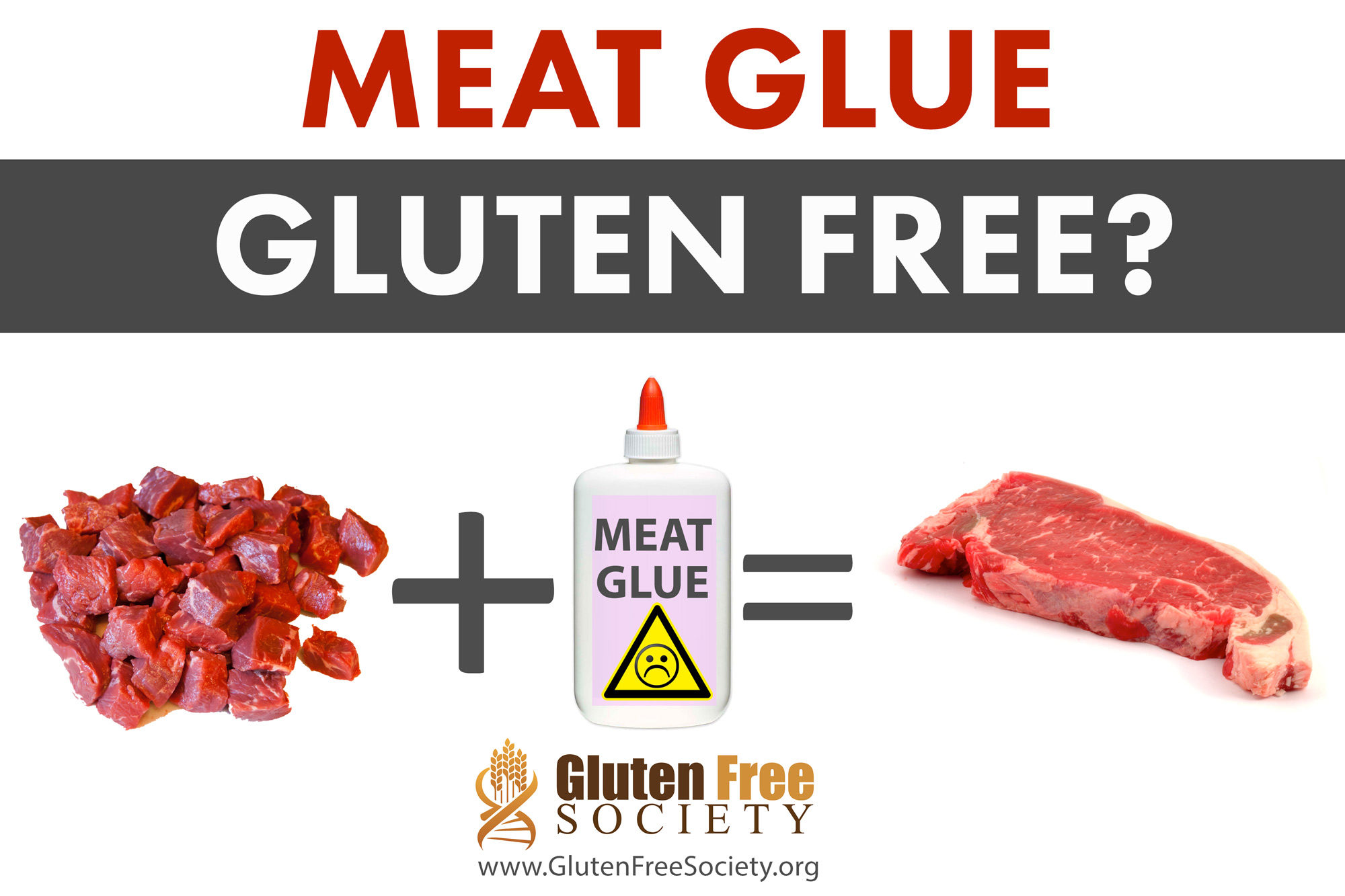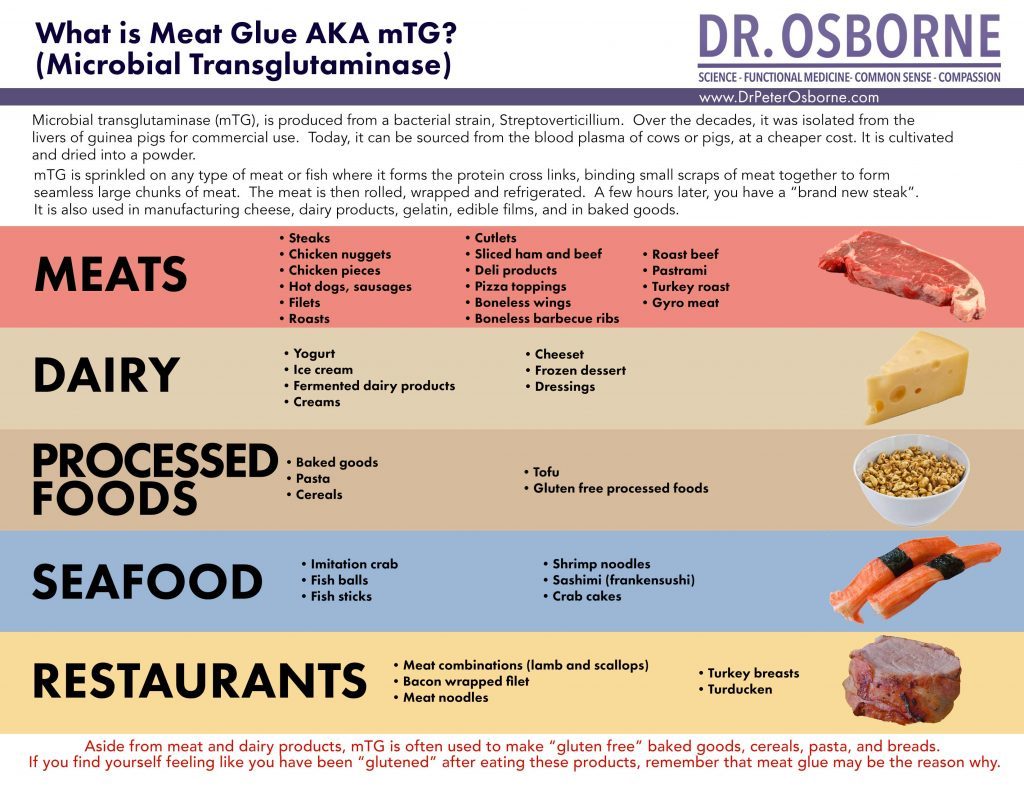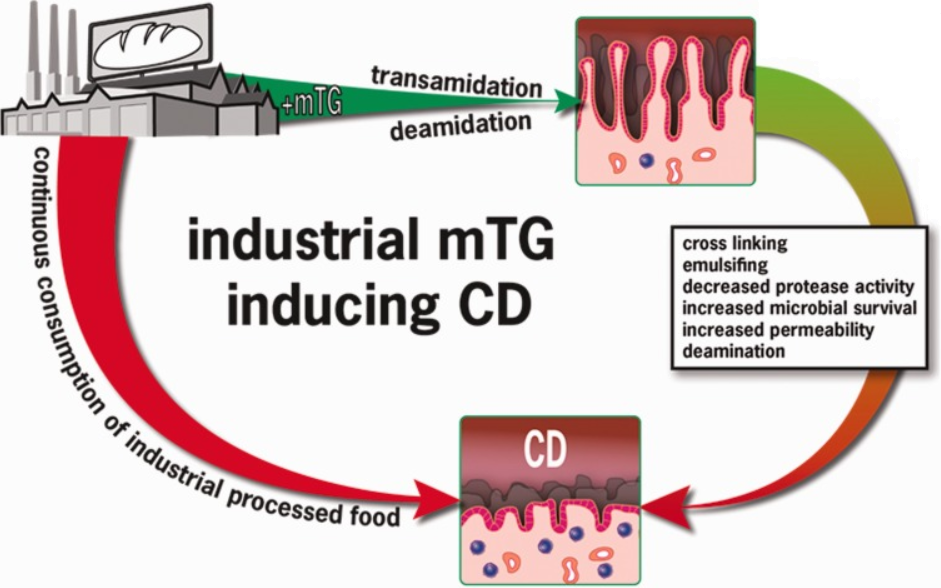What is mTG (Microbial Transglutaminase) - AKA Meat Glue
Microbial transglutaminase (mTG), is produced from a bacterial strain, Streptoverticillium1. Over the decades, it was isolated from the livers of guinea pigs for commercial use. Today, it can be sourced from the blood plasma of cows or pigs, at a cheaper cost. It is cultivated and dried into a powder. mTG is sprinkled on any type of meat or fish where it forms the protein cross links (pink slime), binding small scraps of meat together to form seamless large chunks of meat. The meat is then rolled, wrapped and refrigerated. A few hours later, you have a "brand new steak". The process is done so well that even butchers can't tell a fake steak from a real steak. It is also used in manufacturing cheese, dairy products, gelatin, edible films, and in baked goods. mTG improves the solubility, emulsifying capacity, foaming properties, and gelation in proteins. It also improves the texture and volumes of bread. Basically, mTG is used to make food look more attractive and appealing to consumers.
Comment: Watch how pieces of meat are glued together to create a more valuable 'joint' of meat:
Aside from meat and dairy products, mTG is often used to make "gluten free" baked goods, cereals, pasta, and breads. If you find yourself feeling like you have been "glutened" after eating these products, remember that meat glue may be the reason why.
Hidden Meat Glue - How to Avoid It
Food manufacturers are not required to inform consumers when they use the pink slime. However, you may see a label that reads, "formed from pieces of whole muscle meat" or "reformed from a single cut."4 Meat glue is commonly used in hot dogs, chicken nuggets, constituted "chicken breast" meat, microwaveable dinner meats, fish sticks, sushi, ham, ribs, dairy products... See the chart below for more details(Click the chart to see it full size).
Meat Glue Can Also be Used as Dairy Glue
I wrote about this problem in my book, No Grain No Pain. The texture of dairy products can also be improved by using mTG. Yogurt is treated with mTG and it produces a thicker and creamier product. Casein, one of the principle proteins in milk, can be modified with mTG to make creams, frozen desserts, ice cream, milk beverages, and dressings. For those with a gluten sensitivity, mTG treated dairy is perceived as gluten to the immune system. Adding mTG to a dairy product is like adding fuel to a fire. Therefore, those with a gluten sensitivity should be cautious of any form of mTG dairy in their diet.
mTG a Major Health Risk for Those With Gluten Issues
mTG can increase the risk for developing or flaring up celiac disease. Current research is focusing on the environmental exposures instead of genetic changes due to the increases in the incidence of celiac disease2. The food industry's goal is to make profits. In doing so, they mislead consumers into buying sub-par products labeled as prime or top quality. You can order a prime steak at a restaurant and it could be made out of scraps of meat glued together with the pink slime, mTG. For those with a gluten sensitivity, this can lead to GI inflammation. This is also seen in gluten free products which are modified with mTG in order to replace the gliadin. The texture of "gluten-free" breads, crackers, cookies can all be improved with mTG, but at a health cost to those with a gluten sensitivity. Gluten free products are already known to have possible cross contamination issues, but the use of mTG opens a proverbial new can of worms. Several studies have shown that food processed with mTG can cause cross reactivity in those with gluten sensitivity. Gluten sensitive and celiac consumers will consume "gluten-free" labeled, mTG processed products and experience inflammatory flare ups.
Biochemically, mTG is involved in three reactions, an acyl-transfer reaction, a crosslinking reaction (transamidation), and deamidation1. Huh??? Basically, mTG alters food proteins to be more sticky, elastic, and resilient. In the deamidation reaction, glutamine (amino acid) is transformed into glutamate by mTG. This process will favor gluten peptide binding to HLA-DQ2 and HLA-DQ8 (celiac genes). Thus, stimulating an immunogenic response. Studies identify this as the key step in the pathogenesis of celiac disease2. This also resembles the ill health effects of consuming monosodium glutamate (MSG) used in many Asian dishes and processed foods.
Meat Glue and Leaky Gut
It is known that gluten can cause a leaky gut. mTG used in food products causes changes in the proteins it binds, and can increase tight junction leakage in the gut (AKA - intestinal permeability). Consuming mTG altered food products mimics the gluten response in the gut. Another possible effect from mTG in the gut is an increased susceptibility to infections for those with celiac disease2. mTG is another factor that can be added to the list of known causes of breaking down the gut's protective barriers.
The FDA has labeled mTG as a GRAS (generally recognized as safe) ingredient. However, the FDA also deemed aspartame as safe, which is known to be toxic. The immune system will recognize "pink slime" or "meat glue" as foreign as typically seen in someone with gluten sensitivity. In addition, consuming unhealthy meats can contribute to colon cancer, bladder cancer, stomach cancer, pancreatic cancer and diabetes by more than 50% in most cases3.
To minimize your health risks associated with ingestion of mTG, choose meats and dairy products from local, organically raised, grass-fed animals. If you are unsure of where your meat is sourced from, ask your butcher or chef. Ask "Is this meat processed or a formed piece of meat made with mTG?" Hopefully, you can get an honest answer, but some chefs will continue deceiving many of their customers. Stick to buying your own meat and cooking it yourself. Avoid the pink slime in "frankenmeat" or "frankensushi"! In addition, do not eat any processed gluten free products or processed meat products. Stay informed by carefully reading your food labels. Lastly, think about what you are putting in your mouth and if the risks are worth it!
References
- Kieliszek, M. and Misiewicz, A. (2013). Microbial transglutaminase and its application in the food industry. A review. Folia Microbiol. 59, 241-25
- Lerner, A., Matthias, T. (2015). Possible association between celiac disease and bacterial transglutaminase in food processing: a hypothesis. Nutrition Reviews. 73(8), 544-552.
- McCullgh, C. (2014). The Dangers of Meat Glue. Retrieved from http://paleoaholic.com/paleo/dangers-meat-glue/
- Meat Glue: What is it and what you should know. (2016). Retrieved from https://delishably.com/food-industry/Meat-Glue-What-It-Is-And-What-You-Should- Know
- Skovbjerg, H., Koch, C., Anthosen, D., Sjostrom, H. (2004). Deamidation and cross-linking ofgliadin peptides by transglutaminases and the relation to celiac disease. Biochimica et Biophysica Acta. 1690(3), 220-230.
- Matthias T, et al. The industrial food additive, microbial transglutaminase, mimics tissue transglutaminase and is immunogenic in celiac disease patients. Autoimmun Rev. 2016 Dec;15(12):1111-1119.






Comment: See also: Dr. Peter Osborne: Why you should go grain-free